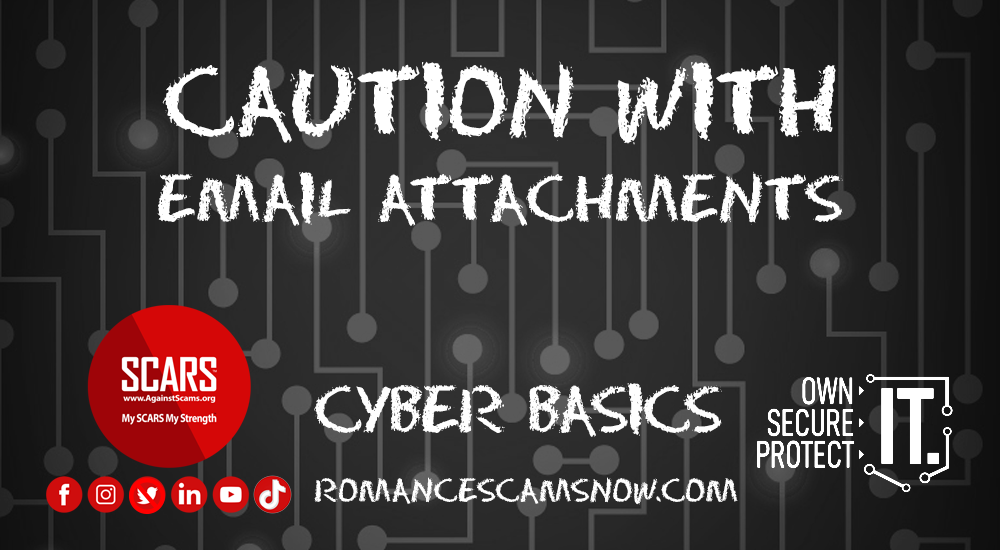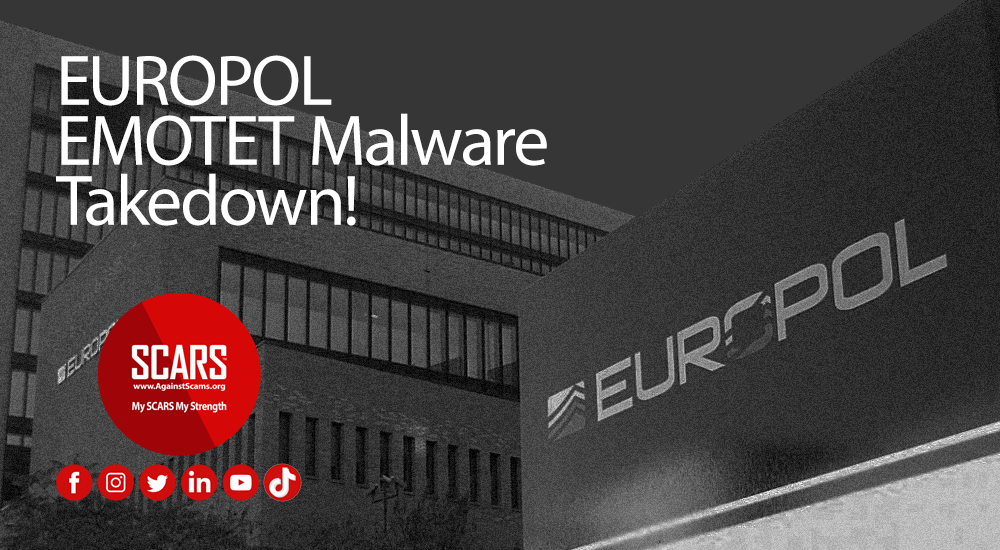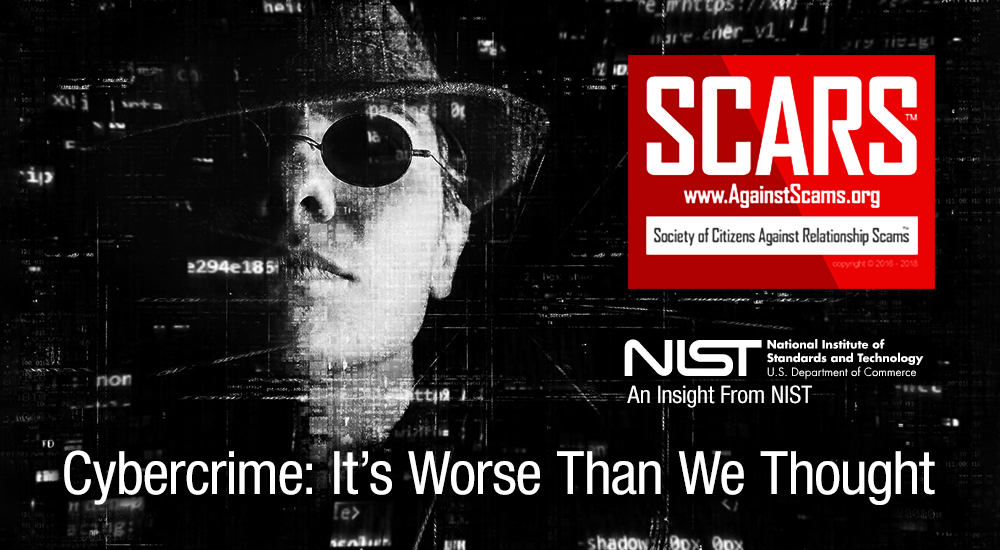
SCARS Institute’s Encyclopedia of Scams™ Published Continuously for 25 Years

Using Caution with Email Attachments
A SCARS Insight
Why Are Attachments A Concern?
While email attachments are a popular and convenient way to send documents, they are also a common source of viruses. Use caution when opening attachments, even if they appear to have been sent by someone you know.
Why can email attachments be dangerous?
Some of the characteristics that make email attachments convenient and popular are also the ones that make them a common tool for attackers:
- Email is easily circulated – Forwarding email is so simple that viruses can quickly infect many machines. Most viruses don’t even require users to forward the email—they scan a users’ computer for email addresses and automatically send the infected message to all of the addresses they find. Attackers take advantage of the reality that most users will automatically trust and open any message that comes from someone they know.
- Email programs try to address all users’ needs – Almost any type of file can be attached to an email message, so attackers have more freedom with the types of viruses they can send.
- Email programs offer many “user-friendly” features – Some email programs have the option to automatically download email attachments, which immediately exposes your computer to any viruses within the attachments.
What steps can you take to protect yourself and others in your address book?
- Be wary of unsolicited attachments, even from people you know – Just because an email message looks like it came from your mom, grandma, or boss doesn’t mean that it did. Many viruses can “spoof” the return address, making it look like the message came from someone else. If you can, check with the person who supposedly sent the message to make sure it’s legitimate before opening any attachments. This includes email messages that appear to be from your ISP or software vendor and claim to include patches or anti-virus software. ISPs and software vendors do not send patches or software in email.
- Keep software up to date – Install software patches so that attackers can’t take advantage of known problems or vulnerabilities. Many operating systems offer automatic updates. If this option is available, you should enable it.
- Trust your instincts – If an email or email attachment seems suspicious, don’t open it, even if your anti-virus software indicates that the message is clean. Attackers are constantly releasing new viruses, and the anti-virus software might not have the signature. At the very least, contact the person who supposedly sent the message to make sure it’s legitimate before you open the attachment. However, especially in the case of forwards, even messages sent by a legitimate sender might contain a virus. If something about the email or the attachment makes you uncomfortable, there may be a good reason. Don’t let your curiosity put your computer at risk.
- Save and scan any attachments before opening them – If you have to open an attachment before you can verify the source, take the following steps:
- Be sure the signatures in your anti-virus software are up to date.
- Save the file to your computer or a disk.
- Manually scan the file using your anti-virus software.
- If the file is clean and doesn’t seem suspicious, go ahead and open it.
- Turn off the option to automatically download attachments – To simplify the process of reading email, many email programs offer the feature to automatically download attachments. Check your settings to see if your software offers the option, and make sure to disable it.
- Consider creating separate accounts on your computer – Most operating systems give you the option of creating multiple user accounts with different privileges. Consider reading your email on an account with restricted privileges. Some viruses need “administrator” privileges to infect a computer.
- Apply additional security practices – You may be able to filter certain types of attachments through your email software or a firewall.
Both the National Cyber Security Alliance and US-CERT have identified this topic as one of the top tips for home users.
PLEASE SHARE OUR ARTICLES WITH YOUR FRIENDS & FAMILY
HELP OTHERS STAY SAFE ONLINE – YOUR KNOWLEDGE CAN MAKE THE DIFFERENCE!
THE NEXT VICTIM MIGHT BE YOUR OWN FAMILY MEMBER OR BEST FRIEND!
By the SCARS™ Editorial Team
Society of Citizens Against Relationship Scams Inc.
A Worldwide Crime Victims Assistance & Crime Prevention Nonprofit Organization Headquartered In Miami Florida USA & Monterrey NL Mexico, with Partners In More Than 60 Countries
To Learn More, Volunteer, or Donate Visit: www.AgainstScams.org
Contact Us: Contact@AgainstScams.org
-/ 30 /-
What do you think about this?
Please share your thoughts in a comment below!
Table of Contents
- A SCARS Insight
- Why can email attachments be dangerous?
- What steps can you take to protect yourself and others in your address book?
- PLEASE SHARE OUR ARTICLES WITH YOUR FRIENDS & FAMILY
- By the SCARS™ Editorial Team
Society of Citizens Against Relationship Scams Inc. - The Issue Of Race In Scam Reporting
Click Here To Learn More!
LEAVE A COMMENT?
Recent Comments
On Other Articles
- Arwyn Lautenschlager on Scam Victim Grooming – Turning On The Instant Emotions: “I can relate to the explanations of the various ways a scammer grooms/manipulate their victim. There were times when I…” Jan 6, 13:56
- on An Updated Compendium Of Confidence Tricks: “In my first scam, I received a $150,000 check address to my scammer from a company in California, but the…” Jan 4, 22:46
- on Romance Scammers – Top Lies They Tell – UPDATED 2024: “Thank you for the valuable information and telling us we just have to report it to the FTC, because the…” Jan 4, 19:12
- on Love Bombing And How Romance Scam Victims Are Forced To Feel: “I was loved bombed and sent flowers, he even asked me to find houses we could live in my town.…” Jan 4, 09:55
- on Scam Grooming: Finding Common Interests: “I was divorced and lost my mom in the same month, I had moved to my hometown and had very…” Jan 4, 09:18
- on Scammers Start By Grooming Scam Victims – Spotting An Online Scam Groomer – Grooming As A Scam Technique – 2024: “As I read this article, I could envision my former self (as if in a movie watching myself) in my…” Jan 3, 13:21
- on The Meaning Behind Scammer Gifts Sent To Romance Scam Victims – 2024: “They were probably purchased using stolen credit cards anyway.” Jan 3, 13:18
- on The Meaning Behind Scammer Gifts Sent To Romance Scam Victims – 2024: “I got flowers from my criminal, he had me take a picture with the flowers. He later gave me several…” Jan 3, 11:23
- on 7 Deadly Sins of Post Scam Victim Vulnerability – 2023 UPDATED 2026: “Thank you for a great article. I will continue to learn, through learning I can gain wisdom, use the steps…” Jan 3, 11:00
ARTICLE META
Important Information for New Scam Victims
- Please visit www.ScamVictimsSupport.org – a SCARS Website for New Scam Victims & Sextortion Victims
- Enroll in FREE SCARS Scam Survivor’s School now at www.SCARSeducation.org
- Please visit www.ScamPsychology.org – to more fully understand the psychological concepts involved in scams and scam victim recovery
If you are looking for local trauma counselors please visit counseling.AgainstScams.org or join SCARS for our counseling/therapy benefit: membership.AgainstScams.org
If you need to speak with someone now, you can dial 988 or find phone numbers for crisis hotlines all around the world here: www.opencounseling.com/suicide-hotlines
A Note About Labeling!
We often use the term ‘scam victim’ in our articles, but this is a convenience to help those searching for information in search engines like Google. It is just a convenience and has no deeper meaning. If you have come through such an experience, YOU are a Survivor! It was not your fault. You are not alone! Axios!
A Question of Trust
At the SCARS Institute, we invite you to do your own research on the topics we speak about and publish, Our team investigates the subject being discussed, especially when it comes to understanding the scam victims-survivors experience. You can do Google searches but in many cases, you will have to wade through scientific papers and studies. However, remember that biases and perspectives matter and influence the outcome. Regardless, we encourage you to explore these topics as thoroughly as you can for your own awareness.
Statement About Victim Blaming
Some of our articles discuss various aspects of victims. This is both about better understanding victims (the science of victimology) and their behaviors and psychology. This helps us to educate victims/survivors about why these crimes happened and to not blame themselves, better develop recovery programs, and to help victims avoid scams in the future. At times this may sound like blaming the victim, but it does not blame scam victims, we are simply explaining the hows and whys of the experience victims have.
These articles, about the Psychology of Scams or Victim Psychology – meaning that all humans have psychological or cognitive characteristics in common that can either be exploited or work against us – help us all to understand the unique challenges victims face before, during, and after scams, fraud, or cybercrimes. These sometimes talk about some of the vulnerabilities the scammers exploit. Victims rarely have control of them or are even aware of them, until something like a scam happens and then they can learn how their mind works and how to overcome these mechanisms.
Articles like these help victims and others understand these processes and how to help prevent them from being exploited again or to help them recover more easily by understanding their post-scam behaviors. Learn more about the Psychology of Scams at www.ScamPsychology.org
Psychology Disclaimer:
All articles about psychology and the human brain on this website are for information & education only
The information provided in this article is intended for educational and self-help purposes only and should not be construed as a substitute for professional therapy or counseling.
While any self-help techniques outlined herein may be beneficial for scam victims seeking to recover from their experience and move towards recovery, it is important to consult with a qualified mental health professional before initiating any course of action. Each individual’s experience and needs are unique, and what works for one person may not be suitable for another.
Additionally, any approach may not be appropriate for individuals with certain pre-existing mental health conditions or trauma histories. It is advisable to seek guidance from a licensed therapist or counselor who can provide personalized support, guidance, and treatment tailored to your specific needs.
If you are experiencing significant distress or emotional difficulties related to a scam or other traumatic event, please consult your doctor or mental health provider for appropriate care and support.
Also read our SCARS Institute Statement about Professional Care for Scam Victims – click here to go to our ScamsNOW.com website.

















Thank you for your comment. You may receive an email to follow up. We never share your data with marketers.